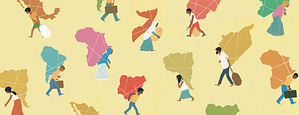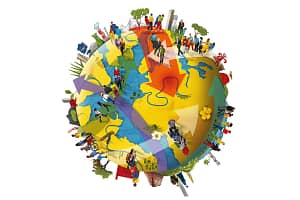Why Do Foreigners Immigrate?
This article shows how much immigration has changed after 2001. How many asylum seekers, students, etc. have come to our country who do not have Dutch nationality from non-Western countries. One of the conclusions is that it is the sharp decrease in asylum migration from molsim countries that has led to a significant drop in the number of immigrants from non-Western countries.
There is also an abbreviated version of this article
This is the third part on the 1st generation of non-Western immigrants (1NWA) 1) Part 1 hole on the composition of the population and part 2 on the number of migrants. Below is another part about the Nyfer report (immigration fees).
foreword
1. Total immigration by nationality
2. Immigration Reasons 1NWA 1996.
3. Comparative periods: before and from 2002.
4. Africa, Latin America and Asia.
5. Morocco, Suriname and Turkey
6. Non-Western Muslim countries and others
conclusion
introduction
Why do foreigners from non-Western countries come to our country? Which country? Do they get a residence permit? What do they bring in terms of education, experience? How long do they stay here? And so you can ask more important questions. One might think that reports can be found on these issues. Good research that provides answers to questions that are an important part of the public debate. False: almost all reports concern groups already present. Not for newcomers. You will find almost nothing about it in the Statistics Netherlands statistic, which contains no less than 2500 tables. The only table on the length of stay of some immigrant immigrants does not contain any administrative correction, so you have nothing. There is no answer to a fundamental and essential question such as: how many people who immigrate with a non-Western passport obtain a residence permit. We don’t know. Not that the question, I suppose, is not easy to answer, but the question was never asked. What worries politicians (and the press) are the IND figures on the number of nominations, but one person can submit several (different) nominations. There are also applications from people who already have a residence permit. Moreover, it does not say anything about the granting of a residence permit. In addition, there are also requests for babies born here (no immigrants at all! In short, politics is concerned with information on which a policy cannot be based. The PVV has been gaining weight for 6 years now. First the big numbers:
1. All immigration by nationality
The CBS table that is closest to answering some of the important questions is immigration. First the numbers:
The table of reasons for immigration concerns foreigners, but I added the Dutch to another table. The Dutch can be born anywhere and probably more than half – in 2009 – are native Dutch, 1/6 second-generation immigrants and almost 1/3 of first generation immigrants, the majority of whom immigrated again. The foreigners in the table are grouped by country of birth. Why is this chart important now? Nationality is very important if you want to make an immigration policy. You can distinguish immigrants – for example 146,000 in 2009 – into three main groups: the Dutch, EU nationals and third country nationals. Of course, you have nothing to do with the Dutch as a government in the context of immigration. Little with EU nationals: their legal position is strong. If you don’t want more, the PVV is the only one to draw the right conclusion: to leave the EU. The remaining 2009 was 54,000 people who immigrated and needed a residence permit. It is a very diverse group: from the adopted Chinese child to an American NATO soldier. From a Somali refugee to a Brazilian student and a Russian migrant wife. It is therefore also true that these 54,000 third-country nationals in 2009 are grouped by country of birth and not by nationality. Of these 54,000, 4,000 (almost all born in a non-Western country) immigrated with EU nationality.
About 50,000 immigrants remain registered by Statistics Netherlands from third countries (which therefore require a residence permit). Not everyone has a residence permit now. Not about 3-4,000. As a result, leers issued for the first time in 2009 about 46 to 47,000 immigrants from third countries, of which 36 to 37,000 were non-Western nationals. Of those 36 to 37,000, I would have liked to know a lot more. Unfortunately – and still strangely enough – this information is not available. We must manage and look at the 43,000 (2009) non-Dutch born in a non-Western country and bear in mind that 15% of them have not received a residence permit (3,000 refused) or do not need it (European passport) 4,000)
As in Parts I and II, I make a distinction between the continents of Asia, Africa and Latin America, the three main non-Western countries of origin: Suriname, Turkey and Morocco. Not the West Indies because only the Dutch come from there, but The Muslim countries 2) and other nationalities.
2. Immigration Reasons 1NWA 1996
CBS’s statistics differ even more than those of the IND. Statistics Netherlands has put an end to the family reunification of asylum seekers (called nareis) in the context of family migration and the so-called Euroroute. At the IND, these are placed with resp. asylum and others.
A very sharp decrease in the number of asylum seekers (article), a slightly smaller decrease in family migration. We are also seeing a sharp increase in the number of migrant workers after 2004 (program for highly skilled migrants), with a further decline in 2009. The number of students has also increased dramatically. Also another period and this is mainly because there were more au pairs au pairs.
immigration remains family migration, although it has decreased somewhat. More than halving asylum. The other share has risen sharply. We see that the share of students has tripled and this also applies to the work factor.
Back to the table of materials
3. Comparative periods: before and from 2002
As in Parts I and II, I divided the period into two groups: before 2002 and from 2002:
We see that 1NWA immigration has decreased by 20%. The number of asylum seekers has decreased by 2/3 and an increase in migrant workers, including highly skilled migrants, students and others. Asylum seekers accounted for only 16% of the total in the last 9 years. Keep in mind that many asylum seekers are ultimately rejected and that family migration also includes nareis (parents of asylum seekers). IND figures include these asylums. The number of asylum seekers who receive a residence permit, including a follow-up trip, could then be the number you see and the number of family migrations without follow-up travel at 14-15,000.
4. Africa, Latin America and Asia
More immigrants come from Asia (including Turkey) than from Africa and Latin America. In proportion, the number of immigrants from Africa has decreased the most, but the number of asylum seekers from Asia has decreased the most. Before 2002, there were 8 times as many asylum seekers as there were students from Asia, but in recent years there were more students than asylum seekers. The same goes for people who come here to work.
Back to the table of materials
5. Morocco, Suriname and Turkey
The following table shows the migration of Morocco, Suriname and Turkey:
The clock is purple: family migration is by far the most important reason for immigration, as this 100% table also shows. There is virtually no labour migration from Morocco and Suriname. Labour migration from Turkey is significant. This is due to the development of Turkey: more educated people and a rapidly growing economy. Asylum migration is still very little from the three countries, but it was not much. You can also see the increase in the number of students from Turkey. Very few students come from Morocco. They’re going to France. In this figure with trend lines, I added the three together.
6. Non-Western Muslim countries and others
Interestingly, the difference between Muslim and other countries is also interesting: the decrease in immigration, as we have seen in Figure 4, is greater than 100% because of immigrants from Muslim countries, because immigration from other countries is increased. Asylum migration has caused the decline: 10,000 fewer per year on average since 2002 and represents only 30% of what it used to be. Family migration has also decreased due to the decline in the number of asylum applications. Asylum still accounts for 25% of immigration in Muslim countries and only 8% in other countries. In other countries, a quarter of immigrants are students. I also made some other trend charts from 1996 non-Western oslim countries,
conclusion
The PVV continued to talk about non-Western immigrants in the 2010 elections and beyond. It had to be reduced by 50%. The total number of immigrants has been constantly discussed. If we look at the figures of non-Western people who obtain a residence permit, for example, the number in 2009 was only 36 to 37,000, or about 25% of the total number of immigrants. It is no coincidence that people who were aware that a 50% reduction – out of a total of 56,000 non-Western foreign immigrants – was not possible at all. It has to do with international treaties, but also because people did not have and did not have the numbers in a row. The total number of immigrants in need of a residence permit has decreased by 20% – due to the decrease in the number of asylum seekers from Muslim countries – since 2002, but more importantly, there has also been a significant shift from asylum seekers to migrant workers and students. As I have already shown, emigration has also increased sharply, especially for the less educated. These changes mean that the composition of the population of the non-Western population changes every day: more educated people and fewer people who are less likely to enter the labour market. As I have already shown, emigration has also increased sharply, especially for the less educated. These changes mean that the composition of the population of the non-Western population group changes every day: more educated people and fewer people who are less likely to enter the labour market. As I have already shown, emigration has also increased sharply, especially for the less educated. These changes mean that the composition of the population of the non-Western population changes every day: more educated people and fewer people who are less likely to enter the labour market.
The “great danger” is immigration from Muslim countries, some say. On average, 2,000 of the 16,000 may be EU national and 2,000 may not receive a residence permit. Of course, the rest will also leave some for the foreseeable future. There’s not much left. It is a good thing that the PVV has shunted up and that the country can deal with the real problems.





More Stories
How Old Are the Migrants? Also the Latest Migration Figures.
Once Again the Prankster of Mass Immigration
Save Emigration Out of Discontent? Are the Netherlands Emptying?